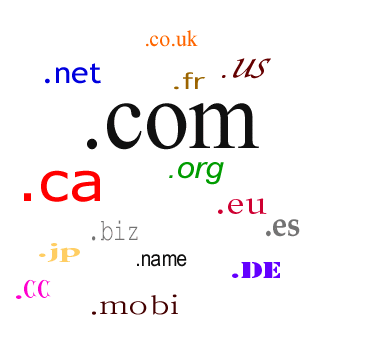Today, domain names are everywhere and they aren’t always used for a company’s website such as HP.com or Apple.com. Domains are now registered to capitalize on all sorts of things like catch phrases, movie titles, personal names, marketing jargon and just about everything else. When it comes to registering your own domain, you’ll want to ask yourself a few questions:
- What message will the domain convey to other people?
- Does it make me sound professional?
- Is it easy to remember?
- Does it infringe on a registered trademark?
- Does it have branding potential?
The most important question is: Is it available? There are millions and millions of domain names out there already, so finding one you like may be a larger process than you anticipated. However, there are plenty of after-market places to buy registered domain names for sale. 
How do I decide what to get?
After answering the questions above, you should have a clearer path to finding the right domain. If this site is going to be your personal website, try using your name or nickname. If you’re using this domain as a business, obviously use your business name, or find something generic that relates to you business. As time goes on, more and more traffic will be coming to your site, so pick a domain that you won’t want to change a year from now. Your domain name is also part of building your brand name.
There are also lots of top level domains (TLDs) to choose from. You might know the top three: .com, .net and .org, but there are over 1600 TLDs worldwide! Each country has at least one like the United States (.US), Tuvalu (.TV), Montenegro (.ME), United Kingdom (.CO.UK) and Western Samoa (.WS). Picking your TLD can be a matter of geographical location, preference or necessity. Keep in mind that foreign domain extensions often cost more and might carry specific restrictions.
Where do I get a domain?
To search for an available domain name and register it, I recommend GoDaddy. I use them for all of my domain services and setting up an account is free. The best part is that, compared to others, they still offer the cheapest domains when you consider all the free services you get.
If the domain you want is already registered, you might be out of luck unless the owner is holding the domain for the “right price”. Yes, domains are sold as commodities these days and some can command millions of dollars. The best advice I can give in this situation is to contact the owner and see if they’re willing to sell. You can do this by finding out the registrant’s email address using Who.is.
Alternatively, you can search after-market domains on sites such as Sedo.com, Afternic.com, SnapNames.com, NameJet.com, BuyDomains.com, GoDaddy.com and Pool.com just to name a few!
Notes
Use your best judgement when registering or buying a domain. When buying, know that there are a lot of scammers out there that will try to steal your money or make a domain seem worth more than it really is. When registering, make sure you’re not treading on someone’s trademark. This can lead to you not only losing the domain name, but also paying huge lawyer’s fees and fines.
A complete list of domain extensions can be found on Wikipedia.
| << Back to Site Creation | Forward to Web Hosting >> |
 any problems with this, but the whole story got me thinking about trademarks in general and the ensuing battles between stakeholders. More specifically, I started thinking about trademarks becoming genericized and what would happen to if Google™ simply became, google…
any problems with this, but the whole story got me thinking about trademarks in general and the ensuing battles between stakeholders. More specifically, I started thinking about trademarks becoming genericized and what would happen to if Google™ simply became, google…